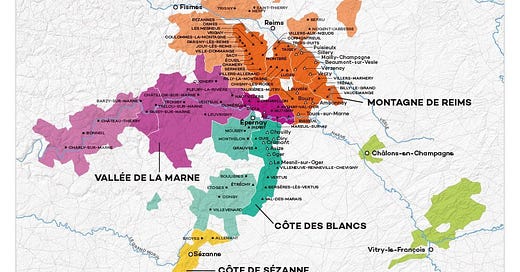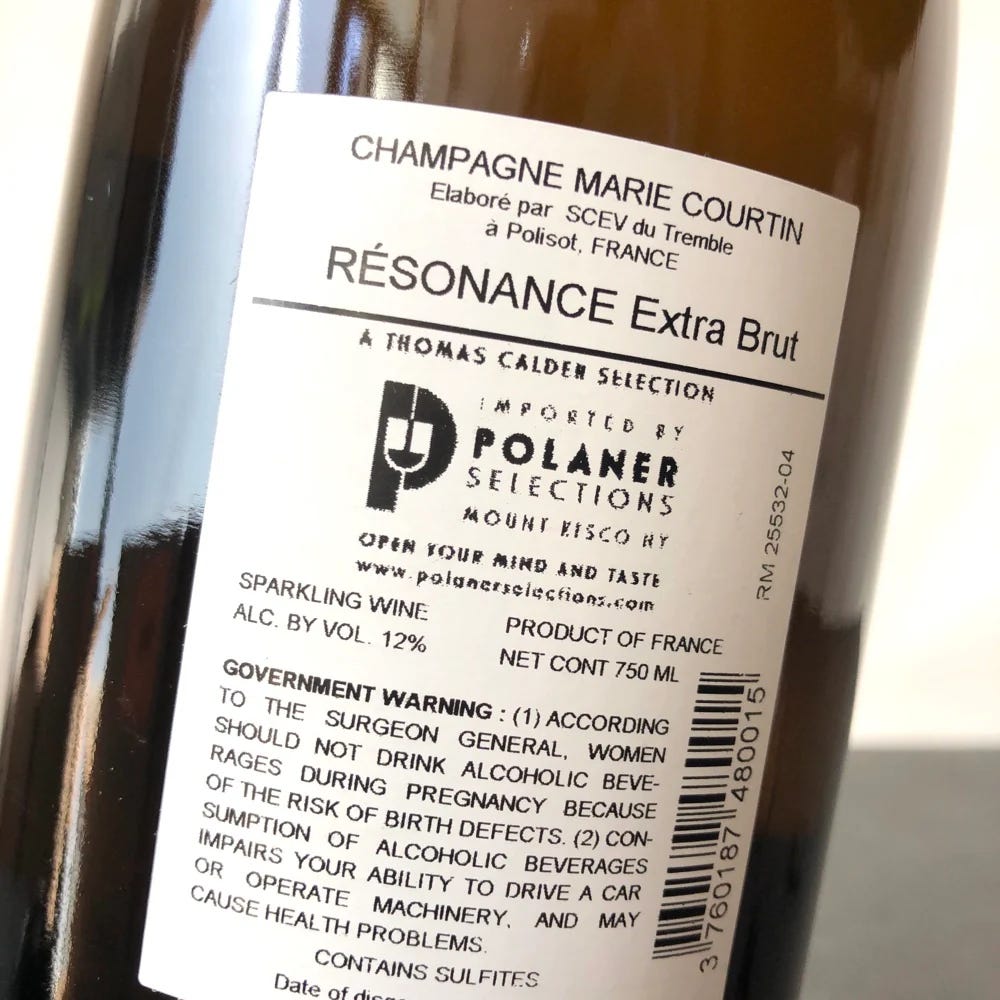ChamPAIN
My kryptonite.
If you haven’t made it this far into your wine journey, consider yourself lucky.
Maybe consider not reading this?
Your wine spend may be high now, but be warned, your champagne vice will take it into the stratosphere.
I spend most of my days trying to find the hit of champagne without the price tag.
Let me paint you the picture.
Champagne
The champagne appellation (area) is about 30,000 hectares. To give you some perspective — New Orleans is about 90,000 hectares. So the Champagne region is 1/3rd the size of tiny-ass New Orleans. AND they make champagne for THE ENTIRE WORLD.
SO… expensive right off the bat due to supply and demand.
A Disclaimer
Also… It HAS to be grown in Champagne, France to be called champagne and be made in the traditional method (AKA charmat, champagne, method traditionnel). Long story short, this method is; making a base wine, putting it through fermentation in a tank, blending, putting it through a second fermentation in a bottle, aging for 15 months on the lees for regular champagne and then minimum 3 years for vintage chamapgne, then disgorging and bottling. I’ll make a whole post on this later, but for now, those are the basics.
Prosecco is not champagne, schramsberg is not “California” champagne, $4 andré is not champagne. Nothing is champagne, except for champagne.
All of these wines can be categorized as “sparkling”, or “bubbles'“. All champagne is sparkling wine. All champagne is bubbles. Not all sparkling wine or bubbles are champagne.
So the next time your friend complains about how the waiter didn’t tell them that the glass of champagne was $28, it was probably your friends fault for confidently ordering champagne and not “prosecco, or sparkling” and the waiter didn’t want to offend them by asking if they were sure.
In my wine-slinging days I always asked “true champagne or sparkling?”. You can very quickly weed out the people that don’t know without asking, “are you sure you can afford it? it’s $28 a glass”. 9/10 times they mean sparkling.
If you only see ‘Champagne’ on the label, that means that the grapes from this wine are sourced from all over champagne.
If you see ‘brut’, this just means “dry” and it’s usually the most common designation for sugar content on the label.
Grapes
Champagne is usually a blend of predominantly chardonnay and pinot noir. Pinot meunier is also used frequently, usually in small quantities, though sometimes on its own. But 9 times out of 10, your champagne will be mostly chardonnay and pinot noir.
Sub-Regions
Champagne has a few sub-regions within the appelation; Montagne de Reims, Valleé de marne, Côtes de blanc, Côtes de Bar, Côtes de Sezanne.
Montagne De Reims (Mountain of Reims) - predominantly pinot noir, gives structure and power. Hosts 10 of 17 grand crus. We’ll discuss crus in a second.
Côtes de Blancs (Hillside/Slope of whites) - almost entirely chardonnay. Known for finesse, minerality, contains 6 grand crus like Avize, Le Mesnil-Sur-Oger.
Valleé de marne (Valley of Marne) - pinot meunier territory - fruit-forward, round supple.
Côtes de bar (Aube) - pinot noir on marl soils; richer, aromatic.
Côtes de Sezanne - extension of côtes de blancs; chardonnay driven, softer on acidity.
Most champagne is a blend of all of these/some of these sub-regions.
If it is one specific one, it will usually say so on the bottle as it will be more sought-after and expensive.
Crus
Within each of these appellations there are different ‘cru’s’ (an entire village known for their specific style based off climate, elevation, slope, soil composition). Daunting, I know.
You’re not expected to memorize all these, but as you go down the rabbit hole, you’ll very quickly find out which ones are your favorites. Especially if you’re dishing out $100+ for each bottle.
Cru Designation
There are standard crus, then Premier (1er) Cru or Grand Cru.
So… there were some sleazy price-fixing rules that were established in 1919 that determined the prices of grapes. Grand cru were in the 100th percentile. Premier cru were in the 90th-99th percentile. Others were between 80-89 percent.
The ‘Êchelle de crus’ system was abolished in 1990 and completely dismantled in 2004.
Today Premier Cru and Grand Cru are traditional, not legally enforced labels, but they remain protected terms, rooted in history.
In reality winemaker skill and vineyard management matter more than cru designation, but the prestige and terroir of different styles still hold much weight on demand and price.
There are 17 Grand Cru Villages.
There are 42 Premier Cru Villages.
Classification
Let’s add another tier of expense.
If you turn around any champagne bottle and look closely around a number with a hyphen, you will see an ‘NM’, ‘CM’, or ‘RM’ before the number.
It’s pretty hidden if you’re not looking for it. Sometimes it’s on the front, sometimes it’s on the side, most of the times it’s on the back. There is no rule to where it goes, but if you’re wondering why it’s $400 it’s probably grower champagne.
NM = Negociant Manipulant. Look at Number 2. This means the producer (winery) buys the grapes from growers in champagne and creates their own wine out of it. Think like a chef buying their ingredients from a local farmers market and making a meal.
CM = Coopérative Manipulant. Which means that the producer (winery) has purchased the finished product from a ‘Co-op’ which is a wine collective (usually a group of ambitious villagers) that pools their resources and makes wine from all the mom and pop growers in their town that don’t want to deal with brands, buyers, etc. Think of this like crowd sourcing. You have chickens, your neighbor has cows, your other neighbor makes bread. A youngin’ from the town collects all the things and then sells one product “a farmers box” (a champagne in this case), everyone gets a cut. You don’t need to worry about dealing with sales reps, demand, etc. You just tend to your chickens, cows, or bread-making. Pretty wholesome. Like all wine things, some of these coops are awesome, others are not.
RM = Recoltant Manipulant. The holy grail. This is the equivalent of farm to table and the rarest of them all. The producer (winery) grows their own grapes, farms their own grapes and produces their own wine in house. Of course everyone would love to do this, but unless your family has been making wine for 1000 years, or you are INCREDIBLY wealthy, there is no land in champagne to buy.
See if you can spot the RM on this one without my help. ^^
Obviously you don’t need it to be grower champagne to be the best, but they’re just so rare you can’t help but get excited.
If you buy Veuve Cliquot, Dom Perignon, Ruinart, you will usually see an NM. Yes they are huge wineries with lots of money, but it’s a double-edged sword, they are TOO big and no chance they are ever owning all of the land that would supply their demand.
CM is usually quality champagne at cheaper prices, but usually overlooked because they don’t have brand recognition. Though there are a few notable ones you may have seen; Nicholas Feuillate, Palmer & Co., Collet.
RM is what I would drink 24/7 if I could afford it. Out of 19,000 growers in champagne, only about 2,000 use the RM classification. Most of it stays in champagne. The rest goes to china. The rest to Europe and surrounding areas. Then, “the scraps” get to the US.
Good luck getting ANY of this.
If you do, expect to pay closer to $200 for these bottles.
I could name Grower champagne all day, but I will just leave you with Marie-Courtin, Pierre-Peters, Jacques Selosse, Bereche & Fils, Jacquesson, Lelarge Peugot, Lahertes Freres, Paul Bara. Beware of the online prices, as I guarantee you cannot buy any of it at that price. Try it. Try buying the jacquesson at $120 a bottle on the first google link. It’s out of stock? shocker.
On top of all of these things, you (the consumer), are also competing with private buyers, other buyers, wine clubs, wine shops, storage facilities, restaurants, etc.
Every sentence I add just adds another $ sign to the price of these things.
The one thing I will leave you with, is that there is nothing like grower champagne.
You can get close to it, but the real thing is EVERYTHING.
Non-Sparkling Appellations
I won’t go too crazy on this as this, but you’ve also got some designations in champagne that aren’t sparkling.
Coteaux Champenois - Still, white and rosé made from champagne grapes. These wines are crazy high in acidity and need lots of time in the bottle. They are also incredibly expensive because they would fetch so much more money (and demand) if they were in a bottle of sparkling wine labeled “champagne”. The everyday consumer has no idea what coteaux champenois is, so it’s always such a tough sell.
I really enjoy it, but I can never justify the cost.
Rosé des Riceys - Very rare rose made from 100% pinot noir grapes from champagne. And guess what, you guessed it, it’s very expensive. You’ll probably be paying closer for $100 a bottle if you can find any of this. I’ll be honest with you, I’ve never seen one, nor tasted one. I haven’t really tried, but after 5 years in the wine game, you’d think I’d happen upon one.
Well, I guess it’s time to pop open some champs and cheers to my dwindling savings account.
Ch-Cheers..





